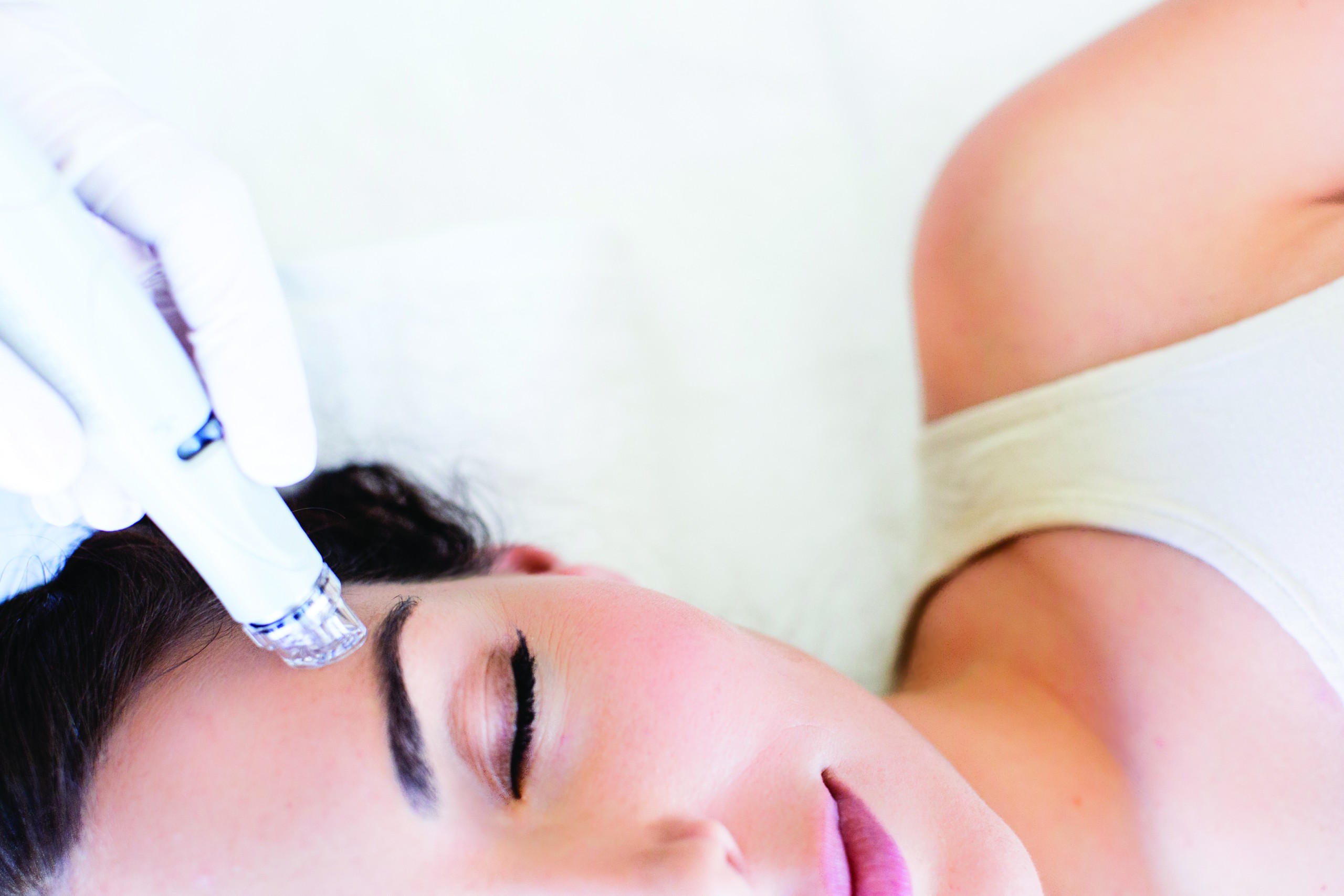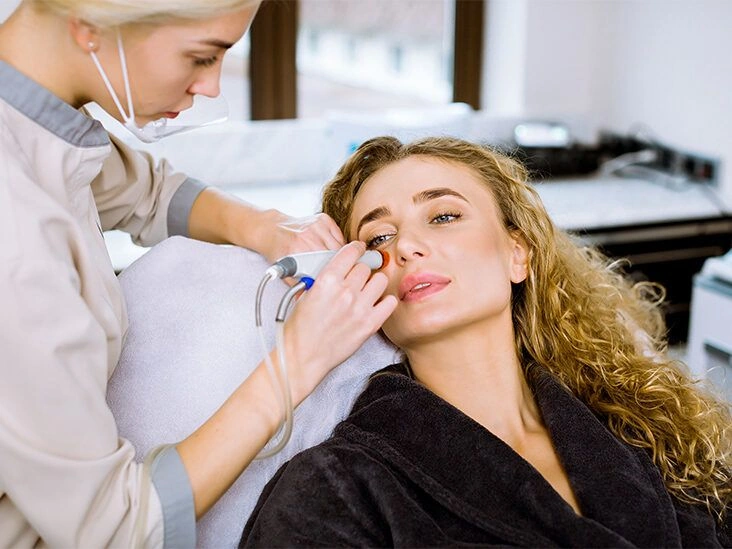Do HydraFacials work?
A HydraFacial is a proprietary skincare procedure offered at medical spas and dermatology clinics. It’s often referred to as “hydradermabrasion” because it combines microdermabrasion-style exfoliation with hydrating serums.
Recognized for its three-step regimen, the HydraFacial aims to deeply cleanse, exfoliate, and hydrate your skin. This professional treatment may address several skin issues, including acne, dryness, and fine lines.
This noninvasive treatment operates on principles similar to a traditional spa facial but is promoted as producing more noticeable outcomes. That effect comes from a mechanized wand applied to the skin to thoroughly cleanse and exfoliate while infusing serums tailored to your skin needs.
If you’re wondering whether a HydraFacial lives up to the buzz, continue reading to learn about potential benefits, possible adverse effects, and how it compares with related treatments.
HydraFacial benefits
HydraFacials are reported to enhance overall skin texture, tone, and appearance. This improvement is attributed to thorough exfoliation that clears pores of buildup, enabling better absorption of serums customized for your skin.

HydraFacial for acne
At present, there are no clinical trials specifically demonstrating HydraFacial’s effectiveness for acne.
Nevertheless, microdermabrasion methods have long been regarded as useful for treating acne and acne scars. This benefit likely stems from deep exfoliation that helps remove skin cells that clog pores.
HydraFacial for blackheads
Accumulation of dead skin cells also contributes to blackheads. This noninflammatory acne variant might gain from the same extraction and exfoliation approaches employed in HydraFacials, but additional clinical research is required to confirm direct benefits.
HydraFacial for rosacea
Finding cosmetic treatments safe for rosacea can be challenging due to the skin’s sensitivity. While more data are needed to establish HydraFacial’s safety and efficacy for rosacea specifically, a 2006 study suggested that comparable techniques may help with papulopustular rosacea.
HydraFacial for anti-aging concerns
A study of 20 women indicated that those receiving HydraFacial treatments experienced greater reductions in signs of skin aging compared with participants who used serums alone. Improvements included smaller-looking pores, reduced hyperpigmentation, and fewer fine lines.
HydraFacial side effects and precautions
Although the HydraFacial is generally described as comfortable, you might feel mild pressure from the wand during treatment. Unlike many other cosmetic procedures, a HydraFacial is not expected to cause pain or prolonged redness.
However, you should avoid this treatment if you have an active rash, such as one from a rosacea flare.
Is HydraFacial safe during pregnancy?
Consult your physician before undergoing any cosmetic procedure while pregnant, including a HydraFacial. A 2017 review found that although many aesthetic treatments may be safe, there aren’t enough clinical studies to conclusively confirm safety in pregnancy.
Can a HydraFacial cause a breakout?
Theoretically, a HydraFacial is designed to address excess oil and dead skin cells that can trigger breakouts. The procedure may also unmask impurities during a skin-purging phase that can follow deep exfoliation.
Before your appointment, inform your provider if your skin is extremely sensitive or if you have allergies to any ingredients that might provoke breakouts after treatment. Contact them if you experience breakouts following a HydraFacial.
How does HydraFacial treatment work?
A licensed aesthetician or dermatologist typically performs a HydraFacial. The treatment is carried out in three stages:
- The provider uses a vortex-style wand on your skin to lift away dirt and oil from deep within pores. They may also apply a peel to exfoliate and resurface the skin.
- The provider uses a vacuum-like tip on the wand to extract debris from pores.
- The provider uses a pen-shaped applicator to infuse a hydrating serum rich in antioxidants.
HydraFacials are sometimes combined with other skincare procedures, like dermal fillers or light therapy, as optional add-ons that are not part of the standard HydraFacial.
HydraFacial before and after
Following a HydraFacial, you may observe smoother, more luminous skin and possibly a more even complexion. Results are often visible immediately, typically without signs of irritation.
HydraFacial aftercare
Each HydraFacial session takes under an hour and requires no downtime. Unlike stronger interventions such as chemical peels, you can usually return to your regular activities right away.
Although you generally shouldn’t see redness or peeling after treatment, it’s wise to avoid other exfoliating procedures for a few days post-HydraFacial.
How often should you get a HydraFacial?
Recommended frequency for HydraFacial treatments varies based on your skin type and your provider’s guidance. Some sources suggest repeating the treatment every 4 weeks, while others recommend sessions as often as every 2 weeks.
An aesthetician or dermatologist can advise on the ideal number and timing of treatments considering your skin concerns and objectives.
HydraFacial costs
HydraFacials are pricier than standard facials, with the average clinic charging around $175 per session. Additional boosters or add-ons will raise the total cost. Pricing can vary by location.
If you’re accustomed to monthly facials plus periodic microdermabrasion or chemical peels, a combined 3-in-1 HydraFacial might prove slightly more economical overall.
As with other cosmetic procedures, HydraFacials are typically not covered by insurance. Ask your provider about ways to save, such as membership plans or monthly discounts.
HydraFacial vs. microdermabrasion
Both HydraFacial and microdermabrasion exfoliate the skin. The main distinction is that microdermabrasion uses fine crystals for exfoliation and is particularly suited to addressing fine lines, wrinkles, age spots, and acne scars. Microdermabrasion also does not deliver serums.
Dermalinfusion vs. HydraFacial
Dermalinfusion uses comparable technology and offers similar benefits to a HydraFacial. Both are three-step procedures that cleanse, exfoliate, and infuse serums based on skin concerns. Dermalinfusion, however, may lead to some redness and irritation afterward.
HydraFacial vs. radiofrequency therapy
Radiofrequency (RF) therapy uses heat energy in deeper skin layers to boost cellular turnover and collagen formation, which can result in firmer, smoother skin. RF may also help improve acne scarring.
While both HydraFacial and RF target signs of aging, RF does not involve exfoliation or serum delivery and can cause temporary redness following sessions.
Takeaway
The HydraFacial may address multiple skin concerns in a single visit through its three-in-one cleansing, exfoliating, and hydrating approach. Consult a dermatologist to determine which cosmetic procedures best match your individual needs.


















Leave a Reply
You must be logged in to post a comment.